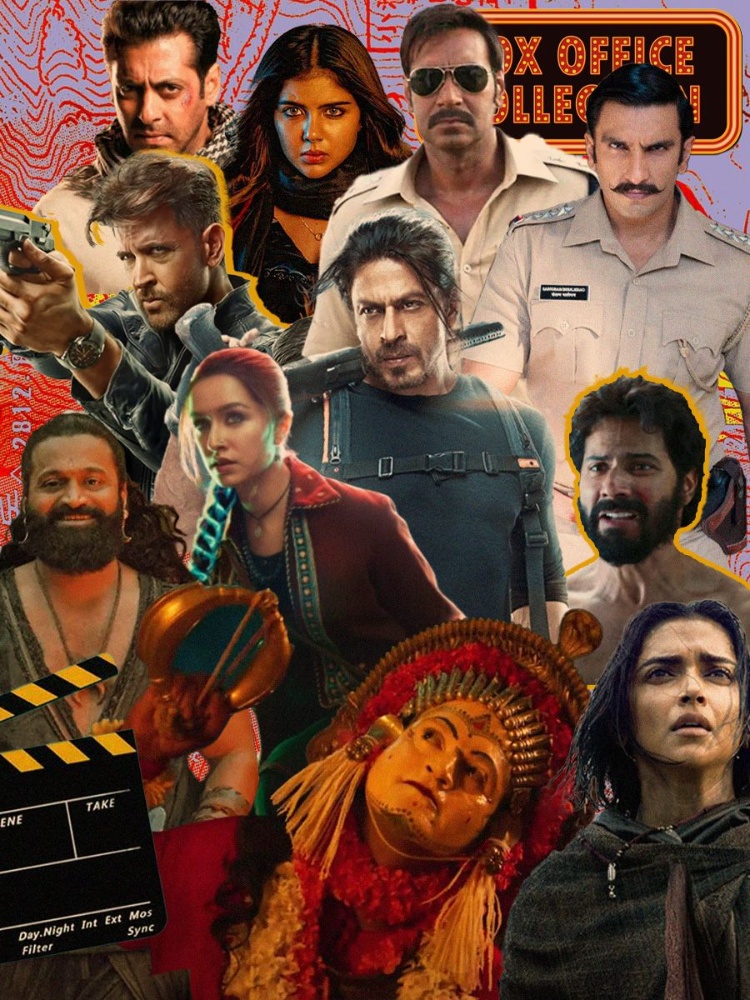If you stayed up until the end of the post-credits scene of Lokah Chapter One: Chandra, you’ll know the Malayalam superhero film gets some things right. With the plotting, characters, casting, balance of humour and action, and political messaging, Dominic Arun’s film about a team of superheroes hits the sweet spot. But where Lokah scores the most is in its careful construction of the cinematic universe contained in the title.
The first in a series—‘Lokah’ itself means ‘universe’—is poised to expand in interesting ways. Like the Hollywood franchises that have inspired it, Chandra has been written by Arun and Santhy Balachandran in such a way that it can spin out in several directions while retaining its core idea. Chandra isn’t just the origin story of the titular vampire (Kalyani Priyadarshan), it also belongs to a group of saviours who are based on Kerala’s rich folklore. Lokah Chapter One: Chandra, which will be streaming on JioHotstar from October 31, features Priyadarshan, but also has Dulquer Salmaan and Tovino Thomas as the vampiress’s peers. But the film judiciously deploys their guest appearances while giving its heroine the full-canvas treatment.
The post-credits sequences contain the germ of future productions focused on characters and plotlines other than Chandra while also teasing the return of fan favourites, such as Naslen’s goofball Sunny. This is world building done right—methodically and expansively rather than half-heartedly. And it’s something other long-running franchises in Indian cinema can learn from today.
Across India, franchises with “To Be Continued” plots and shared characters abound. Dubbed into several languages, these franchises seek to go beyond their core audiences and aim for a pan-India presence. YRF Spy Universe. Kantara Universe. Maddock Horror Comedy Universe. Kalki Cinematic Universe. Lokesh Cinematic Universe. Rohit Shetty’s Cop Universe. And now Lokah Cinematic Universe... Like their counterparts in Hollywood, Indian filmmakers and studios are churning out epic-length narratives. But many miss the mark on the parameters that make a good movie franchise.
The elements that make franchise building interesting—stories that meaningfully intersect, characters who change or mutate in interesting ways, plot twists or cliffhangers—are missing. Instead, what we see on screen is the yoking together of characters from disparate story threads. Add to it some predictable cameos and there is the unavoidable suspicion that the first film of the series is being remade over and over again, give or take a few aspects.
When Stree, starring Rajkummar Rao and Shraddha Kapoor, came out in 2018, it went on to become a hit. In Amar Kaushik’s cocktail of mild scares with ample laughs, the actors and sidekicks, the songs...everything seemed to work. A sequel seemed inevitable even when other writers replaced Raj & DK.
Instead, producer Maddock Films announced the Maddock Horror Comedy Universe, in which different characters battled different enemies inspired by Indian folklore and urban legends but in the same half-funny, half-scary vein. Stree was followed by Kaushik’s Bhediya (2022), starring Varun Dhawan as Bhaskar, who becomes a werewolf.
Bhaskar has a cameo in Aditya Sarpotdar’s Munjya (2024), about a goblin who terrorises a young man (Abhay Verma) and his love interest (Sharvari). Stree 2 (2024) not only has Bhaskar in the post-credits scene, it also features a scene teasing the addition of Akshay Kumar to this world. In Sarpotdar’s recently released Thamma (2025), Bhaskar’s werewolf is seen clashing with the freshly minted vampire Alok (Ayushmann Khurrana).
The fact that between Stree and Bhediya, Maddock Films produced a separate horror-comedy, Roohi (2021), which also happened to star Rajkummar Rao playing a wholly different character, appears to suggest that the universe-building idea was more retrofitted than planned. Such after-the-fact thinking is already beginning to weigh.
The franchise fatigue is especially evident in the wear and tear you see in the YRF Spy Universe. It supposedly began with Kabir Khan’s Ek Tha Tiger (2012), about an Indian RAW agent (Salman Khan) chasing a Pakistani nuclear scientist while falling in love with the scientist’s handler (Katrina Kaif). A sequel by Ali Abbas Zafar duly arrived in 2017. And in 2019, Siddharth Anand’s War, led by Hrithik Roshan, seemed like yet another high-octane action film about Indian agents bashing international baddies.
At this point, there was a ka-ching moment. Audiences were told that these films were always meant to be linked, while the sameness of the Tiger movies and War was passed off as franchise building. Meanwhile, more A-listers and big-name directors were recruited to ensure cross-pollination.
This approach worked best for Anand’s Pathaan, Shah Rukh Khan’s dazzling comeback that included a fun cameo from Salman Khan’s Tiger. But Maneesh Sharma’s Tiger 3 (2023) and Ayan Mukerji’s War 2 (2025) only exposed the haste with which the universe had been built. The series continues with the upcoming Alpha, starring Alia Bhatt and Sharvari.
Without well-written characters or the extra layers needed to pad formulaic plots—something the James Bond and Mission: Impossible franchises do well—our spy universe is on the verge of looking tired, even though we are nowhere close to the Marvel Cinematic Universe’s record of 37 films and 15 series (and counting).
It’s easy enough to announce a franchise, to add a “Part One” or “Chapter One” to a title. But world building is hard, and maintenance harder. Without a foundation of pre-existing material such as comic books (Marvel, DC, X-Men, Superman, Batman), novels featuring recurring characters (James Bond, Jack Reacher, Jason Bourne), or television shows (Mission: Impossible), filmmakers are hard-pressed at times to imagine new ways to expand a saleable idea.
Rohit Shetty’s Cop Universe comprises three Singham movies (2011, 2014 and 2022), Simmba (2018), and Sooryavanshi (2021), but besides gimmicky cameos and the fact that they’re all about daredevil cops walking in slow motion while cars blow up in the background, there’s little to tie them together.
The Lokesh Cinematic Universe (LCU), immodestly named after its creator, Lokesh Kanagaraj, is not very different from the YRF Spy Universe. Five years after their vigilante action thriller Kaithi (2019), heavily inspired by Hollywood film Assault on Precinct 13 (1973), came out, Kanagaraj rolled out Vikram, itself a successor to the film of the same name from 1986. While a massive consignment of cocaine that goes missing threads together the plots of Kaithi and Vikram, the next film in the LCU, Leo (2023), starring Vijay and Trisha, was a standalone story shoehorned into the franchise. (A voice appearance by Kamal Haasan’s Vikram doth not a franchise make.)
Of course, film franchises are fan favourites. Audiences pay good money to ensure their survival and obediently remain in their seats after the lights come on. But sometimes, sequels fare better than the original production. Take Stree 2 and Bhool Bhulaiyaa 2, which became box-office scorchers without the pressure of a grand universe. “Why did Kattappa kill Baahubali?” proved enough motivation for fans to troop into theatres for Baahubali 2: The Conclusion (2017) after the mega success of 2015’s Baahubali: The Beginning, the film that spawned the “pan-India film” phenomenon. But not every movie deserves a follow-up, let alone a franchise.
Like Lokah, Nag Ashwin’s sci-film Kalki 2898 AD (2024) gives every indication of having been planned as a series rather than a single outing. Inspired by the Mahabharata epic and Hollywood dystopian films, Kalki 2898 AD sees Prabhas play a bounty hunter who gets embroiled in a nefarious project that enslaves women. The visual-effects-heavy movie has convincingly futuristic sets, characters who don’t outstay their welcome, and an intriguing open ending that loops back to the battle of Kurukshetra in the Mahabharata.
Perhaps this is what is missing from most of the retroactively constructed franchises today—a thought-through view rather than a hasty reaction to a film that made tonnes of money. And perhaps that’s why Priyadarshan and Dominic Arun can both rest assured—because fans will welcome the return of the enigmatic Chandra and her posse.






